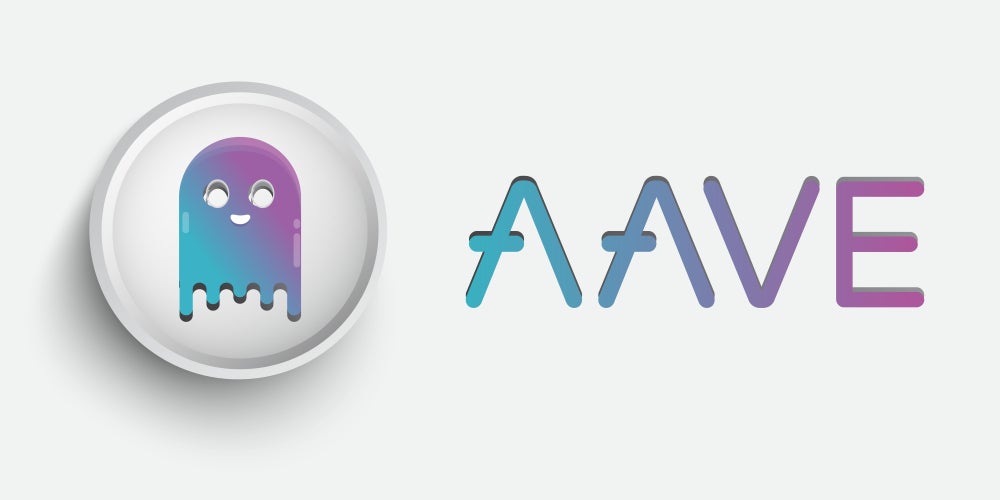The AAVE token is a key element of the Aave ecosystem, one of the leading decentralized financial (DeFi) protocols that allows users to lend, borrow crypto assets, and participate in the governance system.
What is AAVE and its role in the Aave protocol?
AAVE is a native token of the Aave ecosystem that functions as a governance token and has several key roles in the protocol.
Founded in 2017 by Stani Kulekhov under the name ETHLend, Aave was rebranded in 2018 to Aave (which means "ghost" in Finnish) and has since become one of the leaders in the DeFi sector.
The protocol is based on Ethereum and other compatible blockchains (Polygon, Avalanche, Arbitrum, Optimism, etc.), allowing users to provide liquidity to pools, borrow assets in excess of collateral, and use innovative features such as flash loans.
The AAVE token, which is an ERC-20 token on Ethereum, has three main functions:
- Governance: AAVE holders can vote on Aave Improvement Proposals (AIPs), which determine the direction of the protocol, such as adding new assets, changing risk parameters, or updating the system.
- Staking and Safety Module: Users can stake AAVE in the Safety Module to secure the protocol against liquidity shortfalls. For this, they receive rewards in the form of AAVE or a share of the protocol, but risk losing up to 30% of their tokens in the event of a liquidity crisis.
- Discounts on commissions: AAVE holders can use the tokens to pay fees in the protocol, receiving discounts that incentivize their retention.
Currently, AAVE is one of the largest DeFi tokens in terms of market capitalization, which as of December 2024 exceeded $3.82 billion, with a price of approximately $250-$251 (depending on the exchanger, for example, Coinbase).
AAVE's all-time high (ATH) was $670 in 2021, while its all-time low (ATL) was $27.66 in 2020.
History and evolution
AAVE has its roots in ETHLend, which was launched in 2017. Back then, the token was called LEND, and $16.2 million was raised during the ICO.
After rebranding in 2018 and launching in 2020 as Aave, a token exchange took place: 100 LEND were exchanged for 1 AAVE, reducing the total supply from 1.3 billion LEND to 16 million AAVE. Of these, about 14.7 million tokens are in circulation as of 2024, and 3 million remain in the ecosystem's reserve fund.
This exchange introduced a governance system, allowing AAVE holders to participate in decision-making through the AIP. Since then, the protocol has expanded to add support for multiple blockchains and introduce features such as flash credits, stable and variable rates, and GHO, a native decentralized stablecoin pegged to the US dollar.
AAVE tokenism
- General offer: 16 million tokens, of which 14.7 million are in circulation (as of March 2024).
- Distribution: The initial allocation was aimed at broad holder involvement and included 23% for the team, but after the rebranding, the focus shifted to decentralization. About 20% tokens are reserved for protocol incentives, updates, and a reserve fund.
- Deflationary mechanisms: Aave is using a buy-and-burn strategy of buying AAVE from reserves to reduce supply and potentially drive up the price. However, the organic demand for the token is limited, with only about 22% holders staking their tokens, which is lower than competitors such as Curve DAO (49%).
Functionality and use
Landing page and debt
Users can provide crypto assets (e.g., ETH, USDT, DAI, WBTC) to Aave's liquidity pools, receiving aTokens (e.g., aETH) in exchange, which accrue interest. Borrowers provide collateral (up to 80% of the current value of the asset) and can borrow at variable or fixed rates. Aave's total blocked value (TVL) as of February 2025 exceeds $21 billion across eight networks.
Flash loans
A unique feature of Aave that allows you to take loans without collateral if they are repaid within one transaction block. This is popular for arbitrage, collateral replacement, or self-liquidation.
GHO
Aave is a native stablecoin that allows users to receive stable liquidity pegged to the US dollar and is used for additional financial transactions.
Advantages of AAVE and the protocol
- Decentralization: Aave is fully decentralized and non-custodial, which means that users control their assets through their own wallets (MetaMask, Ledger, etc.), without intermediaries.
- Innovations: The protocol is a leader in DeFi thanks to its flash credits, GHO stablecoin, and support for multiple blockchains (Ethereum, Polygon, Avalanche, Arbitrum, etc.).
- Security.: Aave is regularly audited by leading firms such as Trail of Bits, OpenZeppelin, and Certora, and has a bug bounty program to identify vulnerabilities. The protocol code is open source and available for inspection.
- Flexibility: Users can choose between fixed and variable rates and receive commission discounts by holding AAVE.
Risks and disadvantages
Liquidation of collateral: If the value of the collateral (e.g. ETH) drops sharply, Aave can liquidate it to cover the debt, charging a 5-10% penalty. This poses a risk to borrowers due to the volatility of cryptocurrencies.
Technical risks: Like any DeFi protocol, Aave is vulnerable to bugs in smart contracts, although audits minimize this risk.
Limited organic demand for AAVE: Only 22% holders staking the tokens, indicating less interest in governance or security compared to competitors such as Curve DAO.
Price volatility: While AAVE has a strong market capitalization, its price ($250-$251 as of March 4, 2025) is well below its all-time high ($670) and the market remains volatile.
Current dynamics and sentiment
According to posts on the X platform, as of February-March 2025, AAVE is generating positive sentiment among some of the community. For example, users note that the Aave protocol has the highest TVL in history, and the token price is experiencing a "second wind" in this cycle, despite falling by 50% from its peak.
There is also mention of a 3.3 update that could be a catalyst for growth, although there are some concerns about its implementation. Aave announced the "Aavenomics" update, which revises the revenue distribution, tokenomics, and economic model, which may affect the future value of AAVE.
The AAVE token is the centerpiece of the Aave ecosystem, one of the leading DeFi protocols offering innovative solutions for landing, debt and liquidity. Its versatility as a governance, staking, and discount token makes it attractive to investors, but liquidation risks, market volatility, and limited organic demand warrant caution.
As of March 4, 2025, AAVE is showing stability with a price of about $250-$251 and a capitalization of $3.82 billion, but its continued success will depend on the implementation of updates such as Aavenomics and the market's reaction to macroeconomic factors.
For investors, AAVE can be an interesting asset if they are ready for the high risks associated with cryptocurrencies and DeFi.


